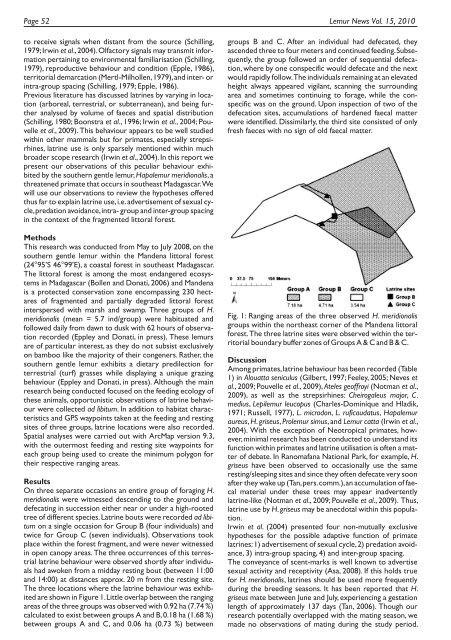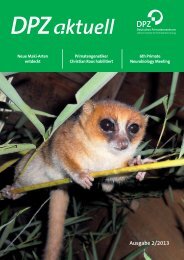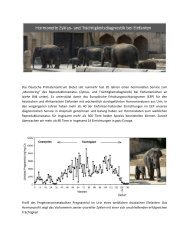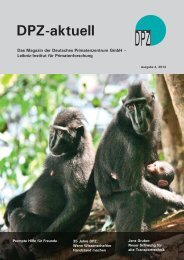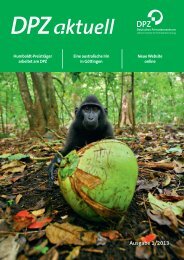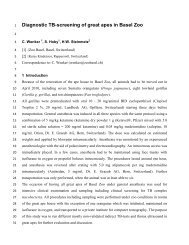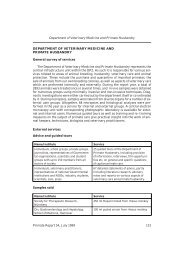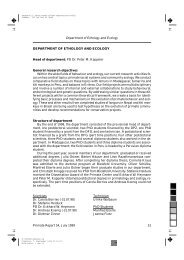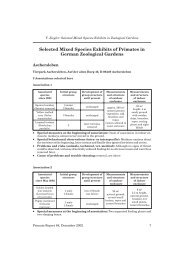Vol. 15 - Deutsches Primatenzentrum
Vol. 15 - Deutsches Primatenzentrum
Vol. 15 - Deutsches Primatenzentrum
You also want an ePaper? Increase the reach of your titles
YUMPU automatically turns print PDFs into web optimized ePapers that Google loves.
Page 52 Lemur News <strong>Vol</strong>. <strong>15</strong>, 2010<br />
to receive signals when distant from the source (Schilling,<br />
1979;Irwin et al.,2004).Olfactory signals may transmit information<br />
pertaining to environmental familiarisation (Schilling,<br />
1979), reproductive behaviour and condition (Epple, 1986),<br />
territorial demarcation (Mertl-Milhollen,1979),and inter- or<br />
intra-group spacing (Schilling, 1979; Epple, 1986).<br />
Previous literature has discussed latrines by varying in location<br />
(arboreal, terrestrial, or subterranean), and being further<br />
analysed by volume of faeces and spatial distribution<br />
(Schilling, 1980; Boonstra et al., 1996; Irwin et al., 2004; Pouvelle<br />
et al., 2009). This behaviour appears to be well studied<br />
within other mammals but for primates, especially strepsirhines,<br />
latrine use is only sparsely mentioned within much<br />
broader scope research (Irwin et al.,2004).In this report we<br />
present our observations of this peculiar behaviour exhibited<br />
by the southern gentle lemur, Hapalemur meridionalis,a<br />
threatened primate that occurs in southeast Madagascar.We<br />
will use our observations to review the hypotheses offered<br />
thus far to explain latrine use,i.e.advertisement of sexual cycle,predation<br />
avoidance,intra- group and inter-group spacing<br />
in the context of the fragmented littoral forest.<br />
Methods<br />
This research was conducted from May to July 2008, on the<br />
southern gentle lemur within the Mandena littoral forest<br />
(24°95’S 46°99’E), a coastal forest in southeast Madagascar.<br />
The littoral forest is among the most endangered ecosystems<br />
in Madagascar (Bollen and Donati, 2006) and Mandena<br />
is a protected conservation zone encompassing 230 hectares<br />
of fragmented and partially degraded littoral forest<br />
interspersed with marsh and swamp. Three groups of H.<br />
meridionalis (mean = 5.7 ind/group) were habituated and<br />
followed daily from dawn to dusk with 62 hours of observation<br />
recorded (Eppley and Donati, in press). These lemurs<br />
are of particular interest, as they do not subsist exclusively<br />
on bamboo like the majority of their congeners. Rather, the<br />
southern gentle lemur exhibits a dietary predilection for<br />
terrestrial (turf) grasses while displaying a unique grazing<br />
behaviour (Eppley and Donati, in press). Although the main<br />
research being conducted focused on the feeding ecology of<br />
these animals, opportunistic observations of latrine behaviour<br />
were collected ad libitum. In addition to habitat characteristics<br />
and GPS waypoints taken at the feeding and resting<br />
sites of three groups, latrine locations were also recorded.<br />
Spatial analyses were carried out with ArcMap version 9.3,<br />
with the outermost feeding and resting site waypoints for<br />
each group being used to create the minimum polygon for<br />
their respective ranging areas.<br />
Results<br />
On three separate occasions an entire group of foraging H.<br />
meridionalis were witnessed descending to the ground and<br />
defecating in succession either near or under a high-rooted<br />
tree of different species.Latrine bouts were recorded ad libitum<br />
on a single occasion for Group B (four individuals) and<br />
twice for Group C (seven individuals). Observations took<br />
place within the forest fragment, and were never witnessed<br />
in open canopy areas. The three occurrences of this terrestrial<br />
latrine behaviour were observed shortly after individuals<br />
had awoken from a midday resting bout (between 11:00<br />
and 14:00) at distances approx. 20 m from the resting site.<br />
The three locations where the latrine behaviour was exhibited<br />
are shown in Figure 1.Little overlap between the ranging<br />
areas of the three groups was observed with 0.92 ha (7.74 %)<br />
calculated to exist between groups A and B,0.18 ha (1.68 %)<br />
between groups A and C, and 0.06 ha (0.73 %) between<br />
groups B and C. After an individual had defecated, they<br />
ascended three to four meters and continued feeding.Subsequently,<br />
the group followed an order of sequential defecation,<br />
where by one conspecific would defecate and the next<br />
would rapidly follow.The individuals remaining at an elevated<br />
height always appeared vigilant, scanning the surrounding<br />
area and sometimes continuing to forage, while the conspecific<br />
was on the ground. Upon inspection of two of the<br />
defecation sites, accumulations of hardened faecal matter<br />
were identified. Dissimilarly, the third site consisted of only<br />
fresh faeces with no sign of old faecal matter.<br />
Fig. 1: Ranging areas of the three observed H. meridionalis<br />
groups within the northeast corner of the Mandena littoral<br />
forest. The three latrine sites were observed within the territorial<br />
boundary buffer zones of Groups A & C and B & C.<br />
Discussion<br />
Among primates,latrine behaviour has been recorded (Table<br />
1) in Alouatta seniculus (Gilbert, 1997; Feeley, 2005; Neves et<br />
al., 2009; Pouvelle et al., 2009), Ateles geoffroyi (Notman et al.,<br />
2009), as well as the strepsirhines: Cheirogaleus major, C.<br />
medius, Lepilemur leucopus (Charles-Dominique and Hladik,<br />
1971; Russell, 1977), L. microdon, L. ruficaudatus, Hapalemur<br />
aureus, H. griseus, Prolemur simus, and Lemur catta (Irwin et al.,<br />
2004). With the exception of Neotropical primates, however,minimal<br />
research has been conducted to understand its<br />
function within primates and latrine utilisation is often a matter<br />
of debate. In Ranomafana National Park, for example, H.<br />
griseus have been observed to occasionally use the same<br />
resting/sleeping sites and since they often defecate very soon<br />
after they wake up (Tan,pers.comm.),an accumulation of faecal<br />
material under these trees may appear inadvertently<br />
latrine-like (Notman et al., 2009; Pouvelle et al., 2009). Thus,<br />
latrine use by H.griseus may be anecdotal within this population.<br />
Irwin et al. (2004) presented four non-mutually exclusive<br />
hypotheses for the possible adaptive function of primate<br />
latrines:1) advertisement of sexual cycle,2) predation avoidance,<br />
3) intra-group spacing, 4) and inter-group spacing.<br />
The conveyance of scent-marks is well known to advertise<br />
sexual activity and receptivity (Asa, 2008). If this holds true<br />
for H. meridionalis, latrines should be used more frequently<br />
during the breeding seasons. It has been reported that H.<br />
griseus mate between June and July, experiencing a gestation<br />
length of approximately 137 days (Tan, 2006). Though our<br />
research potentially overlapped with the mating season, we<br />
made no observations of mating during the study period.


